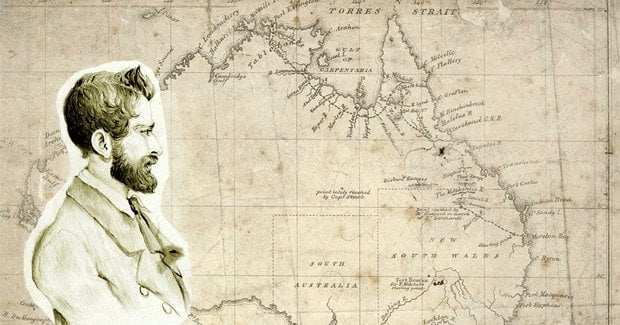A Prussian naturalist and explorer, Leichhardt embarked on several expeditions that extended the frontiers of knowledge and expanded our understanding of the Australian continent. His daring journeys through uncharted lands, meticulous scientific observations, and enduring spirit of adventure make him a trailblazer in Australian exploration. This article delves into the life, expeditions, and lasting legacy of Ludwig Leichhardt, a true pioneer of exploration and natural history.
Born on October 23, 1813, in Trebatsch, Prussia, Ludwig Leichhardt possessed an insatiable curiosity about the natural world from an early age. He pursued studies in natural history, geology, and botany, developing a deep understanding of the scientific principles that would guide his future explorations. Leichhardt’s love for adventure and his desire to uncover the mysteries of the world set the stage for his remarkable career.
The Great Journey of 1844:
In 1844, Leichhardt embarked on his most famous and ambitious expedition, known as the Great Journey. Accompanied by a small team of fellow scientists and explorers, he set out from Jimbour Station in Queensland, with the goal of crossing the continent from east to west. This expedition would take them through some of the most challenging and inhospitable terrains of Australia.
During the Great Journey, Leichhardt meticulously mapped and documented the previously unexplored regions of the Australian interior. His observations and measurements provided valuable insights into the geography, geology, and natural history of the continent. Leichhardt’s maps, which charted vast stretches of land and watercourses, were instrumental in advancing the understanding of Australia’s interior.
Leichhardt’s expeditions brought him into contact with various Indigenous communities, including the Aboriginal peoples of the regions he traversed. His interactions with these communities were marked by curiosity, respect, and a desire to understand their cultures and traditions. Leichhardt’s journals and writings provided valuable insights into the Indigenous way of life and their deep connection to the land.
Tragically, on his third major expedition in 1848, Leichhardt and his team vanished without a trace. The fate of their journey remains a mystery, as no definitive evidence of their whereabouts or fate has ever been found. The enigma surrounding Leichhardt’s disappearance has only added to the mystique surrounding his name and the legacy he left behind.
Leichhardt’s expeditions were not only focused on exploration but also on scientific research. He collected and documented a vast array of plant and animal specimens, making significant contributions to the fields of botany, zoology, and natural history. His detailed observations enriched our understanding of the unique flora and fauna of Australia.
Despite the mystery surrounding his disappearance, Ludwig Leichhardt’s expeditions and scientific contributions had a lasting impact on Australian exploration and natural history. His fearless spirit of adventure, meticulous scientific observations, and passion for discovery inspired subsequent generations of explorers and scientists.
Leichhardt’s legacy is evident in the many landmarks, institutions, and geographical features that bear his name. From the Leichhardt River in Queensland to the Leichhardt Tree in Western Australia, these tributes stand as reminders of his indelible contributions to Australian exploration.
Conclusion:
In conclusion, Ludwig Leichhardt’s expeditions and scientific contributions have left an indelible mark on the history of Australian exploration and natural history. His daring spirit of adventure, meticulous scientific observations, and passion for discovery have inspired generations of explorers, scientists, and nature enthusiasts.
Leichhardt’s expeditions through the uncharted lands of Australia, including the Great Journey of 1844, opened up new frontiers of knowledge and expanded our understanding of the continent’s geography, geology, and natural history. His meticulous mapping and documentation of previously unexplored regions provided valuable insights into the Australian interior.
The encounters with Indigenous communities during his expeditions showcased Leichhardt’s respect for their cultures, traditions, and knowledge of the land. His observations and writings shed light on the diverse Indigenous cultures and their deep connection to the Australian landscape.
Tragically, the mystery surrounding Leichhardt’s disappearance on his third major expedition has only heightened his enigmatic legacy. The circumstances of his fate remain unknown, adding an air of intrigue and fascination to his name.
Leichhardt’s scientific contributions to the fields of botany, zoology, and natural history are undeniable. His collection and documentation of plant and animal specimens enriched our understanding of Australia’s unique flora and fauna.
The legacy of Ludwig Leichhardt lives on through the many landmarks, institutions, and geographical features that bear his name. From rivers and trees to parks and memorials, these tributes serve as a testament to his pioneering spirit and enduring contributions to Australian exploration.
In conclusion, Ludwig Leichhardt’s expeditions and scientific achievements continue to inspire and fascinate. His legacy as a trailblazer in Australian exploration and natural history remains an integral part of the country’s rich heritage.
References:
- Beckett, Jeremy. Ludwig Leichhardt: Lost in the Outback. Random House Australia, 2005.
- Leichhardt, Ludwig. Journal of an Overland Expedition in Australia, from Moreton Bay to Port Essington. Hordern House, 2006.
- Macknight, Campbell. Ludwig Leichhardt: A Biography. Melbourne University Press, 1996.
- Moorehead, Alan. Cooper’s Creek: Tragedy and Adventure in the Australian Outback. Harper Perennial, 2001.
- Webb, Caroline. Great Australian Explorers. HarperCollins Publishers, 2007.
- Dickinson, Frederick Robert. The Life and Explorations of Ludwig Leichhardt. Libraries Board of South Australia, 1966.


